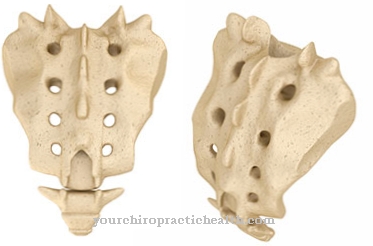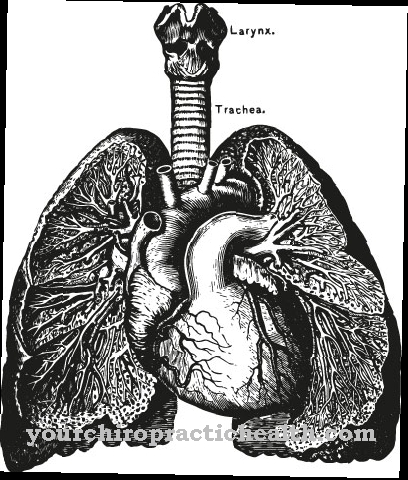The Transverse myelitis is a neurological syndrome that is associated with damage to nerve cells in the spinal cord. In many cases, treatment with cortisone leads to almost complete rehabilitation.
What is Transverse Myelitis?

© designua - stock.adobe.com
Transverse myelitis (TM) is a neurological disorder associated with inflammation of the spinal cord. "Myelitis" stands for inflammation of the spinal cord and "transverse" refers to the fact that the entire cross-section of the respective spinal cord segment is affected. The inflammatory processes in the spine damage nerve cells by attacking the myelin sheath around the nerve fiber.
Myelin plays an important role in the transmission of electrical signals in the central nervous system. In transverse myelitis, the transmission speed is significantly reduced. TM is a relatively rare disease. Statistically, men and women are equally affected. Adolescents between the ages of ten and nineteen and adults between the ages of 30 and 49 have the highest risk of developing TM.
causes
In idiopathic transverse myelitis, the cause is unknown. It is probably an autoimmune disease. This leads to an overreaction of the immune system in which healthy tissue is permanently damaged. Multiple sclerosis (MS) is an autoimmune disease in which the myelin sheath of nerve cells in the brain is destroyed.
Transverse myelitis could have a similar course of disease, but in which the nerve cells of the spinal cord are damaged. Occasionally the condition occurs in conjunction with another condition. For example, TM can develop as a result of an infection. An infection with pathogens such as the HIV virus, the Epstein-Barr virus, herpes zoster or the rabies pathogen leads in rare cases to transverse myelitis.
Bacterial diseases such as tuberculosis, Lyme borreliosis or syphilis are also suspected of causing TM. In addition, this neurological disorder rarely occurs with autoimmune diseases such as sarcoid or MS. In addition, TM can be due to a thrombosis of the spinal arteries. The spinal arteries are responsible for supplying the spinal cord with blood.
Symptoms, ailments & signs
The symptoms of TM depend heavily on the affected area of the spinal cord. The first symptoms appear within hours to weeks after the onset of the disease. In about half of those affected, the inflammation reaches its peak within the first day. Complaints arise because there are motor neurons in the spine that can no longer perform their work adequately.
The exchange of information between the body periphery such as the extremities and the brain is disrupted. Those affected suffer from sensory disorders and back pain. In severe cases, functional disorders of the urinary bladder and rectum occur. The first sign of transverse myelitis is usually a feeling of weakness in the legs.
Occasionally, the weakness can also appear in the arms. There is a loss of sensitivity below the affected spinal cord segment. Typical symptoms of TM are numbness of the legs and trunk and decreased sensitivity to pain. The temperature perception is also largely changed.
Sexual dysfunction is widely observed in connection with this disease. In severe forms, the muscle weakness develops into paraplegia or spastic paralysis. In addition, patients suffer from mood swings, are exhausted and are prone to depressive moods.
Diagnosis & course of disease
At the beginning of the diagnosis, the attending physician takes a detailed anamnesis. Characteristic symptoms such as insensitivity to pain in the legs can be tested, for example, by the patient's reaction to a needle stick. After the first suspected diagnosis, magnetic resonance imaging and an examination of the spinal fluid are usually carried out.
The course of the disease depends heavily on the circumstances of the individual case. If treatment is given on time, most patients recover completely. However, recovery is slow and can take months to years. Some symptoms, such as a slight tingling sensation in the legs, may persist even after the inflammation has healed.
Complications
If transverse myelitis is left untreated over a long period of time, it can lead to secondary symptoms and sometimes serious complications. The disturbed exchange of information initially makes sensory disturbances and back pain noticeable. A severe course results in functional disorders of the urinary bladder and the rectum.
This is accompanied by a feeling of weakness in the legs, which becomes stronger as the disease progresses and ultimately causes serious movement disorders. In individual cases, this symptom also occurs in the arms. Due to the reduced sensitivity to pain that occurs with advanced TM, there is an increased risk of injuries, as the person affected no longer perceives burns and hypothermia properly.
A negative course can cause spastic paralysis up to paraplegia. Psychological complaints are also possible: mood swings, depressed mood and chronic exhaustion for example. When treating transverse myelitis, side effects from prescribed antibiotics and antivirals are possible.
Plasmapheresis carries the risk of infections and bleeding disorders. In a few cases, injuries can occur at the site of the puncture or the patient has an allergic reaction to the agents and materials used.
When should you go to the doctor?
If you feel sick, feel unwell or your physical performance is reduced, you should consult a doctor. An increased body temperature, irritability and inner restlessness indicate an existing illness. Sensitivity disorders on the skin, irregularities in the perception of touch and a loss of muscle strength are signs of an illness. Medical examinations are necessary to clarify the cause. Changes in heart rhythm, functional disorders and irregularities in the digestive tract should be presented to a doctor.
Characteristic of the disease are abnormalities in the activity of the urinary bladder in a severe course. A doctor should therefore be consulted immediately in these cases. If there are restrictions in movement, exhaustion, mood swings or symptoms of paralysis, a doctor is also required. The person concerned needs medical care so that the symptoms are alleviated. In addition, a visit to the doctor must be initiated if behavioral problems become apparent.
Depressive moods, aggressive tendencies and a sharp decrease in well-being should be presented to a doctor. The physical irregularities are often concentrated in the area of the spine. If there is different temperature perception, numbness or sensitivity to pain, there is cause for concern and a need for action. To avoid complications or secondary diseases, a doctor should be consulted immediately.
Treatment & Therapy
Therapy should be given as soon as possible to prevent permanent damage to the nerves in the spine. The administration of medication containing cortisone helps to dampen the excessive immune reaction and to counteract the inflammation. If there is a bacterial or viral infection, antibiotics or antivirals are administered.
In some cases, plasmapheresis as part of acute therapy is promising. This is a process in which antibodies are selectively filtered out of the blood. In transverse myelitis, the antibodies that attack the myelin layer of the nerve fibers in the spinal cord are removed. However, this treatment is only applicable in special cases.
Successful acute therapy is followed by the rehabilitation phase, in which the original physical fitness is to be restored. Disorders of coordination, paralysis and muscle weakness are treated with physiotherapy. Heat applications and massages help with pain and restricted mobility.
In order to maintain the successes achieved in the long term, self-training at home is important. Depending on the severity of the disease, drug therapy may also be necessary after acute therapy and rehabilitation. This is based on the individual needs of the person concerned. It is not uncommon for pain medication to continue to be required.
prevention
Targeted prevention is not possible. The long-term consequences of bacterial or viral infections can largely be prevented if a doctor is consulted in good time. In addition, it is important to end therapies as prescribed and not to discontinue treatment prematurely. In the case of neurological deficits such as numbness, a specialist should be consulted immediately. This improves the prognosis of transverse myelitis in many cases.
Aftercare
For transverse myelitis, aftercare is primarily concerned with physical rehabilitation. In this phase, the organism receives gentle support in restoring its state of health. According to the doctor's recommendation, the patients should improve their coordination again and overcome the muscle weaknesses. Targeted physiotherapy takes place for this purpose.
Massages and heat applications help against illness-related pain and restrictions. Later self-training after this therapy ensures long-term success and strengthens the body. In some cases, medication may be required to reduce the pain. Long-term rehabilitation plays a major role in the aftercare phase.
It is used to remove the functional restrictions. In connection with neurological recovery, it is also important to combat psychological problems such as anxiety and depressive moods. Those affected often feel restricted in their performance and their self-confidence decreases. Intensive psychotherapy counteracts such complexes and increases self-esteem.
To monitor the improvement in health, doctors recommend keeping a complaint diary. This is not only suitable for entering symptoms such as numbness, which can indicate long-term effects. Patients should also keep track of their medication intake.
You can do that yourself
Transverse myelitis requires medical attention. The most important self-help measure is to keep a complaint diary and otherwise follow the medical guidelines regarding the intake of medication. If complications arise, it is advisable to see a doctor.
Transverse myelitis requires intensive rehabilitation. Physiotherapy and physical treatments are important accompanying measures. Patients can use heat and baths at home to relieve pain and impaired function. The aim of neurological rehabilitation is to avoid anxiety and depression. The affected people often feel that they are not able to perform well and as a result also develop emotional complaints. Therapeutic treatment can improve self-esteem.
The therapy also includes massages, Stangerbaths and a wide variety of activation and relaxation treatments. These include water massages, mediwave or treatment using bass vibrations. Self-training is essential for successful treatment. It is best for patients to speak to a specialist and have an individual therapy program put together, which they can carry out at home without medical assistance. The Myelitis Association V. can name further measures and means and give the patient contact points for treatment and accompanying therapy.



























